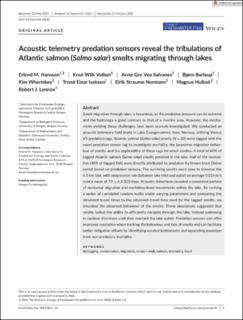| dc.contributor.author | Hanssen, Erlend Mjelde | |
| dc.contributor.author | Vollset, Knut Wiik | |
| dc.contributor.author | Salvanes, Anne Gro Vea | |
| dc.contributor.author | Barlaup, Bjørn | |
| dc.contributor.author | Whoriskey, Kim | |
| dc.contributor.author | Isaksen, Trond Einar | |
| dc.contributor.author | Normann, Eirik Straume | |
| dc.contributor.author | Hulbak, Magnus Andre | |
| dc.contributor.author | Lennox, Robert | |
| dc.date.accessioned | 2022-04-08T10:59:48Z | |
| dc.date.available | 2022-04-08T10:59:48Z | |
| dc.date.created | 2021-12-01T23:28:12Z | |
| dc.date.issued | 2021 | |
| dc.identifier.issn | 0906-6691 | |
| dc.identifier.uri | https://hdl.handle.net/11250/2990750 | |
| dc.description.abstract | Smolt migration through lakes is hazardous, as the predation pressure can be extreme and the hydrology a great contrast to that of a riverine area. However, the mechanisms yielding these challenges have been scarcely investigated. We conducted an acoustic telemetry field study in Lake Evangervatnet, Voss, Norway, utilising Vemco V5 predation tags. Atlantic salmon (Salmo salar) smolts (N = 20) were tagged with the novel predation sensor tag to investigate mortality, the lacustrine migration behaviour of smolts, and the applicability of these tags for smolt studies. A total of 60% of tagged Atlantic salmon (Salmo salar) smolts perished in the lake. Half of the mortalities (30% of tagged fish) were directly attributed to predation by brown trout (Salmo trutta) based on predation sensors. The surviving smolts were slow to traverse the 6.5 km lake, with progression rate between lake inlet and outlet on average 0.016 m/s over a mean of 7.9 ± 6.2 (SD) days. Acoustic detections revealed a consistent pattern of nocturnal migration and multidirectional movements within the lake. By running a series of correlated random walks under varying parameters and comparing the simulated travel times to the observed travel time used by the tagged smolts, we emulated the observed behaviour of the smolts. These simulations suggested that smolts lacked the ability to efficiently navigate through the lake, instead swimming in random directions until they reached the lake outlet. Predation sensors can offer improved resolution when tracking the behaviour and fate of smolts and can facilitate better mitigation efforts by identifying survival bottlenecks and separating predation from non-predatory mortality. | en_US |
| dc.language.iso | eng | en_US |
| dc.publisher | Wiley | en_US |
| dc.rights | Navngivelse 4.0 Internasjonal | * |
| dc.rights.uri | http://creativecommons.org/licenses/by/4.0/deed.no | * |
| dc.title | Acoustic telemetry predation sensors reveal the tribulations of Atlantic salmon (Salmo salar) smolts migrating through lakes | en_US |
| dc.type | Journal article | en_US |
| dc.type | Peer reviewed | en_US |
| dc.description.version | publishedVersion | en_US |
| dc.rights.holder | Copyright 2021 The Author(s) | en_US |
| cristin.ispublished | true | |
| cristin.fulltext | original | |
| cristin.qualitycode | 1 | |
| dc.identifier.doi | 10.1111/eff.12641 | |
| dc.identifier.cristin | 1963059 | |
| dc.source.journal | Ecology of Freshwater Fish | en_US |
| dc.source.pagenumber | 424-437 | en_US |
| dc.relation.project | Norges forskningsråd: 320726 | en_US |
| dc.identifier.citation | Ecology of Freshwater Fish. 2021, 31(2), 424-437. | en_US |
| dc.source.volume | 31 | en_US |
| dc.source.issue | 2 | en_US |

